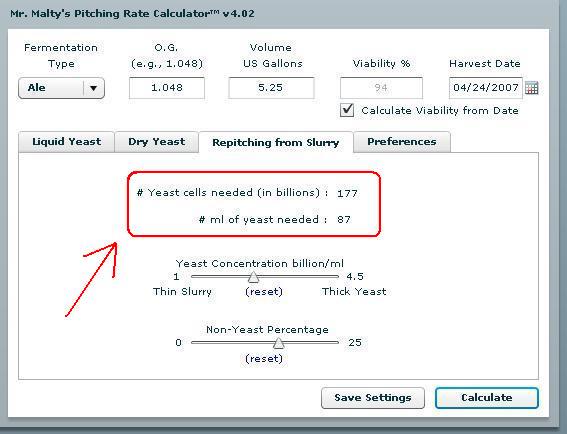|
Calculations
These fields are calculated by the program. These numbers will change depending on the numbers you
enter for the batch of beer you're trying to make. See the instructions page of this help file for information on entering those parameters.
# Yeast Cells Needed (in Billions)
This is the number of yeast cells needed to properly ferment a given wort. For all practical purposes, most homebrewers won't need to know this number, because it is
difficult to count the cells without a microscope. Instead, most brewers use the amount of yeast slurry in ml as an estimate of how much yeast to pitch.
# ml of Yeast Cells Needed
This volume of yeast cells needed, in ml, to properly ferment a given wort. While you want to be fairly close in the amount of yeast you pitch, this doesn't need high precision measurements. An easy way to estimate how much yeast you have is to use containers of 1 liter or 500 ml in size. If the 500 ml container is 1/2 full, you have 250 ml of yeast slurry. If it looks like it is 1/4 full, you have about 125 ml of slurry. Guesstimate and you should be close enough.

|
|
Yeast Concentration billion/ml
This setting allows you to adjust for how thick a slurry you're measuring. If you've ever seen the yeast packed hard into the bottom of a White Labs vial, that is Thick Yeast at 4.5 billion cells per ml. When you harvest a yeast slurry and it has settled for a few hours, that is a thin slurry. Usually, most homebrewers will let their yeast settle for a few days in the fridge between one batch and the next. When you do, you'll notice the yeast has settled a bit and is sort of jelly-like. That is the default setting on the calculator. You'll need to estimate from there for other yeast thickness, but what is most important is keeping track of what you pitched and the results you get from the beer. If you need to adjust up or down, that is OK, just keep track of how you do things each time.
Once you've determined how much yeast you have in the container, you can shake the container along with any liquid to loosen up the yeast. If you determine there is 200 ml of yeast solids in the container and you want to pitch 100 ml. Shake the container to break up the yeast and then pour 1/2 of this very loose yeast slurry into your beer.
|
|
Non-Yeast Percentage
You slurry contains more than just yeast. There are coagulated proteins, hop bits, dead cells, and other non-yeast solids in the bottom of your cake. Generally, at least 10% of
a slurry is non-yeast material, often closer to 15%. If you can see visible non-yeast material, the amount is probably 25%. It is unusual for yeast harvested from a fermenter to have less than 10% of
non-yeast material. You can adjust the setting for non-yeast material that you feel is in your slurry by moving this slider. The default is 15% and that is average for most homebrewers.
|